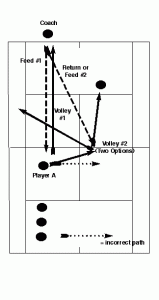
Poaching on an Angle
In order to effectively poach, players must poach not only laterally, but on an angle, to increase the angle they have to put the volley away, as well as to decrease the time the ball has to run away from them and drop due to gravity.
The diagram below shows an effective poaching path for net players to take, as opposed to the common lateral path taken by more inexperienced players. Players must learn to cross the center service line and make a commitment to switching sides with their partner.
The following drill will help your players practice the most effective angle to the ball when poaching.
| Step #1 — Have players line up in a single file line, with the first player (Player A) lining up at the net in the deuce court (as if his or her partner were serving and he or she were at their starting position. All other players should wait in line behind the service line.
Step #2 — Player A receives a feed from the coach who is directly in front of Player A, on the baseline, similar to where Player A’s opponent would be receiving serve. Player A attempts to volley the ball back to the coach, who plays the ball crosscourt, similar to a return of serve. If your players or you do not have the control to do this, have Player A use the first volley as a practice volley, then bounce-feed a second ball crosscourt, similar to a return of serve. Step #3 — Player A moves to poach immediately before the coach feeds the second ball (as the ball bounces), moving on an angle two finishing two steps past the center service line. Step #4 — Depending on whether the poacher is left-handed or right-handed, the poacher hits the volley across his or her body, either at the feet of the opposing opponent, now directly across the net from them at on ad court service line (this player would be represented by a cone, or with an actual player who tries to play out the point), or on a sharp angle away from both opponents. Step #5 — Player moves to end of line. Variation — Players can begin on the service line, receiving a mid-court volley from the coach, working their way into the net, then receiving the two volleys in the previous sequence. |
 |





